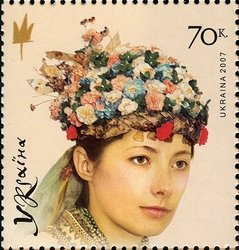Stamp: Garland; unknown origin (Ukraine 2007)
Garland; unknown origin (Ukraine 2007)
23 August (Ukraine ) within release Traditional Head-dresses goes into circulation Stamp Garland; unknown origin face value 70 Ukrainian kopiyka
| Stamp Garland; unknown origin in catalogues | |
|---|---|
| Michel: | Mi:UA 882 |
Stamp is vertical format.
in souvenir sheetAlso in the issue Traditional Head-dresses:
- Stamp - Garland; unknown origin face value 70;
- Mini Sheet - Traditional Wedding Head-dresses of Ukrainians face value 12*70;
- Stamp - Garland; Land of Polissya face value 70;
- Stamp - Garland; The Land of Ivano-Frankivsk face value 70;
- Stamp - Garland; Land of Lviv face value 70;
- Stamp - Garland; Land of Kyiv face value 70;
- Stamp - Ampyx and Plaitings; Land of Ivano-Frankivsk face value 70;
- Stamp - Garland; Land of Lviv face value 70;
- Stamp - Hat; Land of Ivano-Frankivsk face value 70;
- Stamp - Garland; Land of Ternopil face value 70;
- Stamp - Hat; Land of Ternopil face value 70;
- Stamp - Garland; Land of Ivano-Frankivsk face value 70;
- Stamp - Hat; Land of Ternopil face value 70;
Stamp Garland; unknown origin it reflects the thematic directions:
A woman is an adult female human. Before adulthood, a woman is referred to as a girl (a female child or adolescent)
A tradition is a system of beliefs or behaviors (folk custom) passed down within a group of people or society with symbolic meaning or special significance with origins in the past. A component of cultural expressions and folklore, common examples include holidays or impractical but socially meaningful clothes (like lawyers' wigs or military officers' spurs), but the idea has also been applied to social norms and behaviors such as greetings, etc. Traditions can persist and evolve for thousands of years— the word tradition itself derives from the Latin word tradere literally meaning to transmit, to hand over, to give for safekeeping. While it is reportedly assumed that traditions have an ancient history, many traditions have been invented on purpose, whether it be political or cultural, over short periods of time. Various academic disciplines also use the word in a variety of ways.
In clothing, a suit is a set of garments made from the same cloth, usually consisting of at least a jacket and trousers. Lounge suits (also known as business suits when sober in colour and style), which originated in Britain as country wear, are the most common style of Western suit. Other types of suit still worn today are the dinner suit, part of black tie, which arose as a lounging alternative to dress coats in much the same way as the day lounge suit came to replace frock coats and morning coats; and, rarely worn today, the morning suit. This article discusses the lounge suit (including business suits), elements of informal dress code.



